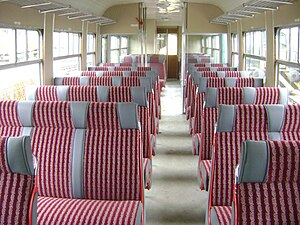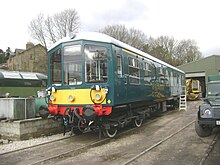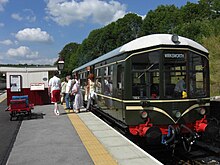| This article needs additional citations for verification. Please help improve this article by adding citations to reliable sources. Unsourced material may be challenged and removed. Find sources: "British Rail Derby Lightweight" – news · newspapers · books · scholar · JSTOR (July 2024) (Learn how and when to remove this message) |
| British Rail Derby Lightweight | |
|---|---|
 Derby Lightweight power car no. 79018 at Bewdley on the Severn Valley Railway Derby Lightweight power car no. 79018 at Bewdley on the Severn Valley Railway | |
 The refurbished seating in the 2nd class saloons of the Trailer Car 79612 - 2021 The refurbished seating in the 2nd class saloons of the Trailer Car 79612 - 2021 | |
| In service | 1954-1969 |
| Manufacturer | BR Derby Works |
| Replaced | Steam locomotives and carriages |
| Constructed | 1954-1959 |
| Number built | 217 vehicles |
| Number preserved | 2 sets |
| Formation | 1, 2 & 4 car formations |
| Capacity | 16 1st + 53 3rd class (motor composite), 61 3rd class (motor third brake) |
| Operators | British Rail |
| Specifications | |
| Car length | 57 ft 6 in (17.53 m) |
| Doors | 2 on each side |
| Maximum speed | 62 mph (100 km/h) |
| Weight | 27 tonnes (26.6 long tons; 29.8 short tons) power car |
| Prime mover(s) | Two BUT |
| Power output | (AEC) 125 bhp (93 kW) except BUT (AEC) 150 bhp (110 kW) for single units |
| Multiple working | ◆ Yellow Diamond |
| Track gauge | 1,435 mm (4 ft 8+1⁄2 in) standard gauge |

The British Rail Derby Lightweight diesel multiple units, were the first such trains to be built en-masse for British Railways. The units were built at BR's Derby Works from 1954 to 1955. The units were built in various formations, including 12 power-twin 2-car units, 84 power-trailer 2-car units, four 4-car units, and two single car units.
Body framing was extruded and riveted together. Panelling was welded into continuous sheets and riveted to the frame. Luggage racks were light alloy. The floors had 2 layers of flameproof hardboard, covered with linoleum. To reduce noise and condensation, the inside structure and undersides were sprayed with asbestos. Lighting was by 60-watt, 24-volt lamps charged by belt driven dynamos. Heating was oil fired. Standard mild steel bogies ran on Timken roller bearings.
Contemporaneous with these units was the unique Battery Electric Multiple Unit.
Operations
The first units were introduced on services around the West Riding of Yorkshire, namely Leeds to Bradford and Harrogate services from 14 June 1954. Subsequent units were introduced onto services in West Cumbria, Lincolnshire, Norfolk, Newcastle to Middlesbrough, Edinburgh to Glasgow and, later, Birmingham to Sutton Coldfield, Bletchley to Buckingham and Banbury, and East London lines services. They were also the last units to run on the Anglesey Central Railway which closed to public traffic in 1964.
These units were extremely successful, helping to reduce the operating costs of branchlines and also attracting many more passengers when new. They carried 800,000 more passengers on the London Midland Region between February and October 1956 than steam did in the same period of 1955. The largest increase was 434% (4,772 passengers) on the Buckingham-Banbury line (from 13 August), followed by Birmingham-Lichfield 178% (from 5 March), Bury-Bacup 152% (from 6 February), Llandudno-Blaenau Ffestiniog 39% (from 5 March) and Manchester-Buxton 38% (from 8 October).
Due to their success, British Railways ordered many more DMU vehicles from various builders over the next decade, thus helping to eliminate steam locomotives. However, as these units were non-standard compared to other later DMU vehicles, they were subject to early retirement. The last units were withdrawn from normal traffic in 1969.
| Lot No. | Type | Diagram | Qty | Fleet numbers | Notes |
|---|---|---|---|---|---|
| 30084 | Driving Motor Brake Second (DMBS) | 501 | 8 | E79000–79007 | ER Power Twin sets |
| 30085 | Driving Motor Composite with lavatory (DMCL) | 507 | 8 | E79500–79507 | ER Power Twin sets |
| 30123 | Driving Motor Brake Second (DMBS) | 503 | 13 | M79008–79020 | LMR Power-Trailer sets |
| 30124 | Driving Trailer Composite with lavatory (DTCL) | 509 | 13 | M79600–79612 | LMR Power-Trailer sets |
| 30126 | Driving Motor Brake Second (DMBS) | 504 | 13 | M79021–79033 | LMR Power-Trailer sets |
| 30127 | Driving Trailer Composite with lavatory (DTCL) | 505 | 13 | M79613–79625 | LMR Power-Trailer sets |
| 30177 | Driving Motor Brake Second (DMBS) | 504 | 13 | M79034–79046 | LMR Power-Trailer sets |
| 30178 | Driving Trailer Composite with lavatory (DTCL) | 505 | 13 | M79250–79262 | LMR Power-Trailer sets |
| 30192 | Driving Motor Composite (DMC) | 502 | 5 | E79508–79512 | ER 4-car sets |
| 30193 | Driving Motor Second (DMS) | 508 | 5 | E79150–79154 | ER 4-car sets |
| 30194 | Trailer Brake Second with lavatory (TBSL) | 517 | 5 | E79325–79329 | ER 4-car sets |
| 30195 | Trailer Second with lavatory (TSL) | 518 | 5 | E79400–79404 | ER 4-car sets |
| 30201 | Driving Motor Brake Second (DMBS) | 633 | 7 | M79143–79149 | LMR Power-Trailer sets |
| 30202 | Driving Trailer Composite with lavatory (DTCL) | 642 | 7 | M79663–79669 | LMR Power-Trailer sets |
| 30235 | Driving Motor Brake Second (DMBS) | 633 | 9 | M79118–79126 | LMR Power-Trailer sets |
| 30236 | Driving Trailer Composite with lavatory (DTCL) | 509 | 9 | M79639–79647 | LMR Power-Trailer sets |
| 30240 | Driving Motor Brake Second (DMBS) | 633 | 10 | M79127–79136 | LMR Power-Trailer sets |
| 30241 | Driving Trailer Composite with lavatory (DTCL) | 509 | 10 | M79648–79657 | LMR Power-Trailer sets |
| 30240 | Driving Motor Brake Second (DMBS) | 527 | 4 | E79137–79140 | ER Power-Trailer sets |
| 30241 | Driving Trailer Composite with lavatory (DTCL) | 631 | 4 | E79658–79661 | ER Power-Trailer sets |
| 30246 | Driving Motor Brake Second (DMBS) | 633 | 2 | M79141–79142 | LMR Power-Trailer sets |
| 30247 | Driving Trailer Composite with lavatory (DTCL) | 642 | 1 | M79662 | LMR Power-Trailer sets |
| 30321 | Driving Motor Brake Second (DMBS) | 633 | 13 | M79169–79181 | LMR Power-Trailer sets |
| 30322 | Driving Trailer Composite with lavatory (DTCL) | 511 | 15 | M79670–79684 | LMR Power-Trailer sets |
| 30324 | Driving Motor Brake Second (DMBS) | 633 | 5 | M79184–79188 | LMR Power Twin sets |
| 30325 | Driving Motor Composite with lavatory (DMCL) | 509 | 5 | M79189–79193 | LMR Power Twin sets |
| 30380 | Driving Motor Brake Second (DMBS) | 514 | 1 | M79900 | Single car unit; 61 seats |
| 30387 | Driving Motor Brake Second (DMBS) | 515 | 1 | M79901 | Single car unit; 52 seats |
Formations
Four different sorts of formation were created from the 217 cars built of this type, as follows:
Power Twins
| Qty | DMBS + DMCL | DMBS + DMCL | |
|---|---|---|---|
| 8 | 79000 + 79500 | to | 79007 + 79507 |
| 5 | 79184 + 79189 | to | 79188 + 79193 |
Power Trailers
| Qty | DMBS + DTCL | DMBS + DTCL | |
|---|---|---|---|
| 26 | 79008 + 79600 | to | 79033 + 79625 |
| 13 | 79034 + 79250 | to | 79046 + 79262 |
| 24 | 79118 + 79639 | to | 79141 + 79662 |
| 1 | 79142 + 79684 | ||
| 7 | 79143 + 79663 | to | 79149 + 79669 |
| 13 | 79169 + 79670 | to | 79181 + 79682 |
Four Car Units
| DMS | TBSL | TSL | DMC |
|---|---|---|---|
| 79150 | 79325 | 79400 | 79508 |
| 79151 | 79326 | 79401 | 79509 |
| 79152 | 79327 | 79402 | 79510 |
| 79153 | 79328 | 79403 | 79511 |
| 79154 | 79329 | 79404 | 79512 |
Single Car Units
| DMBS |
|---|
| 79900 |
| 79901 |
79683 was left over as a spare DTCL, and took the place of 79649 in 1957, when this was converted into a special saloon on diagram 565. It was later renumbered 999510 in the departmental saloon series and was eventually scrapped in 1981.
In 1962 three of the power twin units were converted to power trailer units, when 79191–79193 were rebuilt as DTCL vehicles and renumbered 79633–79635.
Powertrain
Power Twins 79000+79500 to 79007+79507
- Engine: Two BUT (Leyland) 125 bhp
- Transmission: Hydraulic, Lysholm-Smith (Leyland) torque converter
- Coupling code: Red triangle
Remainder of the fleet
- Engine: Two BUT (AEC) 150 bhp
- Transmission: Mechanical
- Coupling code: Yellow diamond
Departmental Use
A number of cars from these units were subsequently transferred to departmental (non-revenue earning) use after withdrawal from normal service:
- 79018 + 79612 were rebuilt as an ultrasonic test train based at Reading, numbered 975007 + 975008. Replaced by unit 901001.
- 79900 was rebuilt as test coach "Iris", based at Bletchley, numbered 975010. Later transferred to the BR Research Division at the Railway Technical Centre at Derby, for its last few years in traffic, it was repainted into original BR Green livery. Replaced by unit 901002.
- 79185 was taken into departmental use for brake trials, numbered 975012. It was scrapped in 1970.
- 79250 and 79252 were taken into departmental use as staff messrooms, numbered 975013 and 975014. They were scrapped in 1978 and 1982 respectively.
- 79649, the inspection saloon mentioned above, took its place in the departmental series as 999510.
Preservation

Thanks to their extended life in departmental service, one 2-car unit and a single car unit survive in preservation on the Ecclesbourne Valley Railway, the former following a high-profile campaign.
| Vehicle Nos. | Location | Comments | In Service | Departmental Nos. | ||
|---|---|---|---|---|---|---|
| DMBS | DTC | DMBS | DTC | |||
| 79018 | 79612 | Ecclesbourne Valley Railway | Used as ultrasonic test train. | Part Restored/Not In Service | 975007 | 975008 |
| 79900 | — | Ecclesbourne Valley Railway | Used as test coach "Iris". | Regularly in Passenger Service | 975010 | — |
See also
- British Rail BEMU – a power-trailer two car EMU based on the Derby Lightweight DMU design.
References
- Cooke, B.W.C., ed. (July 1954). "Lightweight Diesel Trains for British Railways". The Railway Magazine. Vol. 100, no. 639. Westminster: Tothill Press. p. 461.
- Cooke, B.W.C., ed. (June 1954). "B.R. Lightweight Diesel Trains". The Railway Magazine. Vol. 100, no. 638. Westminster: Tothill Press. p. 369.
- Cooke, B.W.C., ed. (July 1954). "Lightweight Diesel Trains for British Railways". The Railway Magazine. Vol. 100, no. 639. Westminster: Tothill Press. p. 458.
- Railway Magazine February 1957 p. 74
Further reading
- Green-Hughes, Evan (February 2012). "The Derby Lightweight DMUs". Hornby Magazine. No. 56. Hersham: Ian Allan Publishing. pp. 88–91. ISSN 1753-2469. OCLC 226087101.
External links
![]() Media related to British Rail Derby Lightweight at Wikimedia Commons
Media related to British Rail Derby Lightweight at Wikimedia Commons
| Diesel and alternative fuel multiple units of Great Britain | |
|---|---|
| Pre-TOPS | |
| First generation | |
| Second generation | |
| Post-privatisation | |
| Diesel-electric | |
| Alternative fuel | |
| Bi-mode | |
| First generation (original TOPS) | |
| Diesel-electric (original TOPS) | |
| Southern Region designations | |
| Design families | |